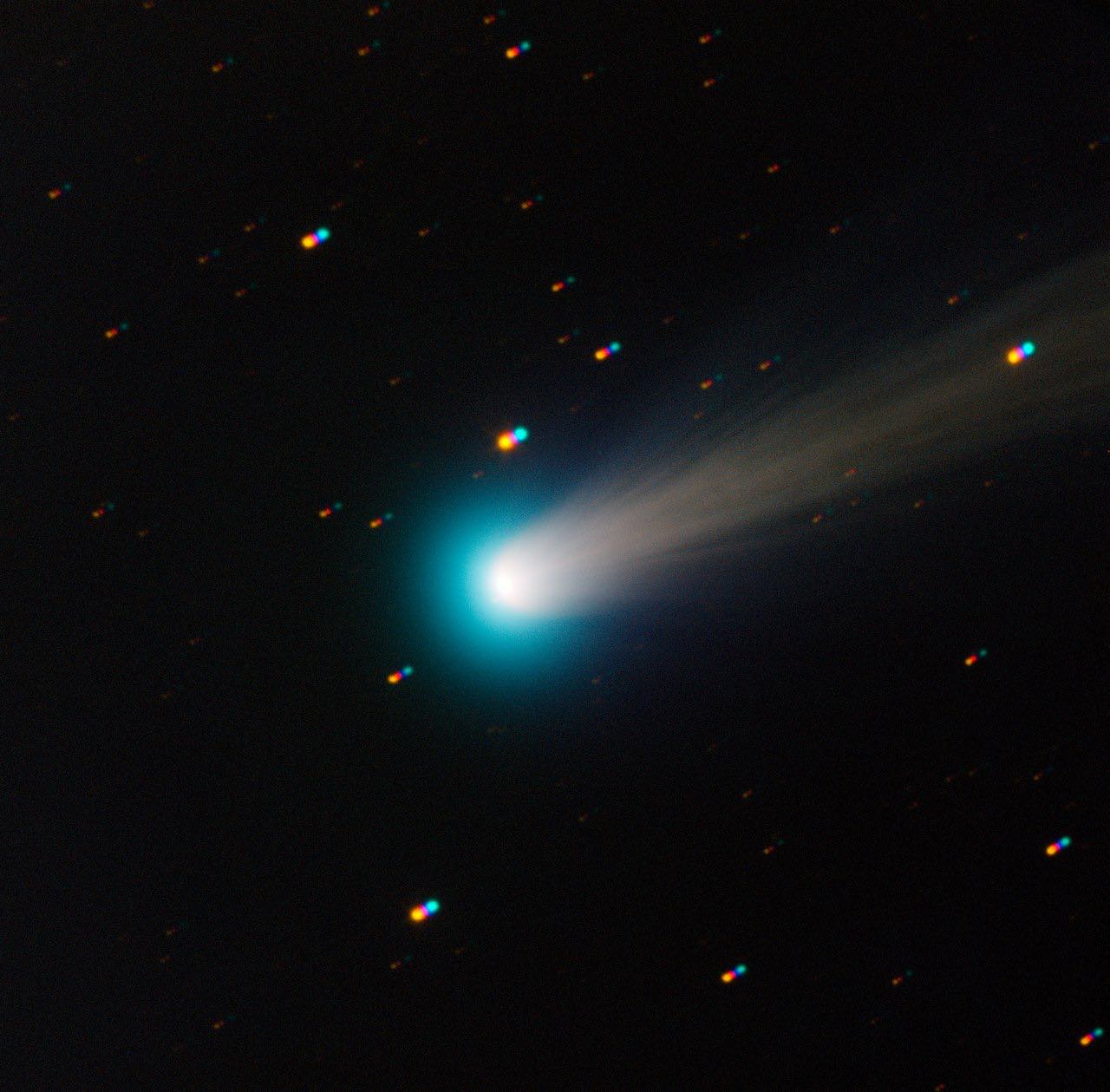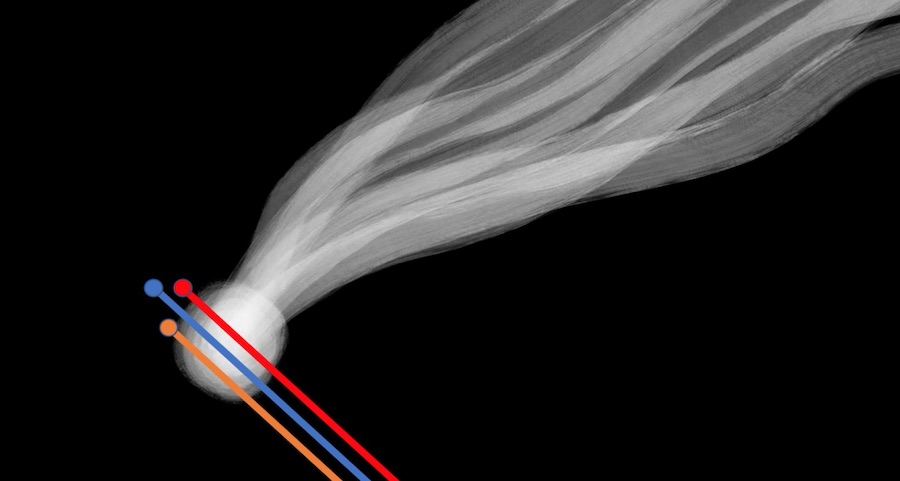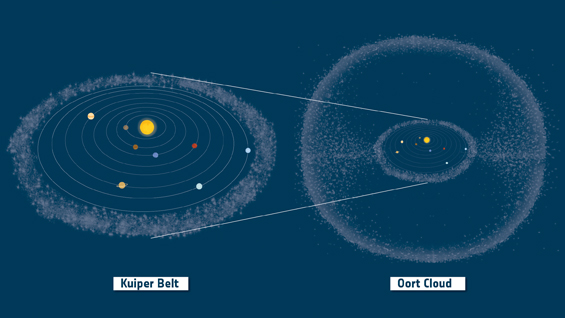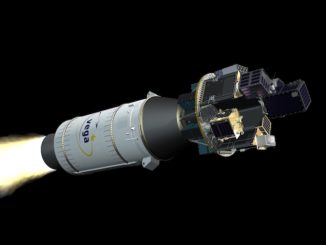
A new flyby mission selected by the European Space Agency this week for launch in 2028 will be the first to intercept a new comet or interstellar object fresh from the frozen depths of the outer solar system, or beyond.
Comprising three spacecraft, the Comet Interceptor mission will hitch a ride to space with ESA’s ARIEL space telescope in 2028 and loiter nearly a million miles (1.5 million kilometers) from Earth until astronomers discover a suitable comet inbound from deep space toward the sun.
Led by scientists in the United Kingdom, Comet Interceptor aims to become the first spacecraft to get a close-up of a “dynamically new” comet, an object that has not passed near the sun before. Spacecraft, so far, have only visited comets that have made repeated passages close to the sun, where solar radiation and heating breaks down ice and other materials left over from the birth of the solar system some 4.5 billion years ago.
The type of comets sought by Comet Interceptor originate in the Oort Cloud, a spherical shell of icy objects located between 200 billion miles (320 billion kilometers) and 9 trillion miles (14 trillion kilometers) from the sun. Scientists believe collisions or close encounters in the Oort Cloud occasionally send frozen objects toward the sun.
“We expect to see something that’s got a truly pristine surface that hasn’t had a chance to evolve,” said Colin Snodgrass, an astronomer at the University of Edinburgh and deputy lead of the Comet Interceptor science team. “All of the comets we’ve gone to so far are short-period comets, and that’s because we had to know where they would be, and know the orbit well enough to plan the mission … They’ve all been orbiting around the inner solar system for very long period of time.”
Comet 67P/Churyumov-Gerasimenko, perhaps the best-known comet after a detailed survey by ESA’s Rosetta mission, is a regular visitor to the inner solar system. It completes one orbit around the sun every six-and-a-half years.
“One of the things that we saw with Rosetta was the amount of dust that’s fallen back onto the surface f the nucleus,” Snodgrass said in an interview with Spaceflight Now. “We saw all of these evolutionary features. The difference here is we’re going to something that’s feeling the heat of the sun for the first time.”
If scientists get lucky, telescopes could detect an incoming object that originated outside our solar system. In 2017, astronomers for the first time discovered an interstellar object as it passed through the solar system.
But the object, named ʻOumuamua, was only detected on the outbound leg of its trajectory, leaving little time for telescopic observations, and no time to develop and launch a mission to explore it.
Two of the most famous comets discovered in the last decade, known as C/2012 S1 (ISON) and C/2013 A1 (Siding Spring) were detected less than two years before they reached perihelion, or their closest point to the sun. Interplanetary probes typically require five years, or longer, to develop from scratch.
Comet Interceptor will solve this dilemma by launching into a holding pattern in space, ready to respond to a new discovery.
“Pristine or dynamically new comets are entirely uncharted and make compelling targets for close-range spacecraft exploration to better understand the diversity and evolution of comets,” said Günther Hasinger, ESA’s director of science, in a press release. “The huge scientific achievements of Giotto and Rosetta — our legacy missions to comets — are unrivaled, but now it is time to build upon their successes and visit a pristine comet, or be ready for the next ‘Oumuamua-like interstellar object.”
Europe’s Giotto mission accomplished the closest flyby of Halley’s Comet in 1986.

After launching on top of an Ariane 62 rocket in tandem with the ARIEL telescope, the three-spacecraft Comet Interceptor mission will travel to the L2 Lagrange point, a gravitational balance point nearly a million miles from the night side of Earth.
Ground-based observatories will scan the sky searching for new comets on trajectories that could be reached by Comet Interceptor.
“We have to have a comet that is in the right place,” Snodgrass said. “We think that will be a few years — up to five years — waiting time to find one that will be reachable with the fuel we have on-board.”
The U.S.-led Large Synoptic Survey Telescope, or LSST, under construction in Chile will be critical in finding a comet destination for the Interceptor mission, Snodgrass said. The new telescope is set to begin regular science operations by the end of 2022, and will image the entire visible sky every few nights, detecting smaller asteroids and comets farther from the sun than ever before.
“This mission is really enabled by the fact that we’re going to have the LSST survey running by the time we need to find a comet,” he said.
With the start of the LSST survey, Snodgrass said scientists expect to find comets with up to five or six years of warning before they reach perihelion, the closest point to the sun in their trajectories.
“That’s enough time for us to really study it, plot the trajectory, and get there,” he said.
Once scientists select a target, Comet Interceptor will fire its engine and depart the L2 Lagrange point, fine-tuning its approach to fly less than 600 miles (1,000 kilometers) from the comet. In the weeks before the flyby, Comet Interceptor will split into three spacecraft — a European-built mothership with a camera, science instruments, propulsion and communications systems, and two daughter satellites, each with their own sensors, provided by ESA and the Japanese space agency.
“It’s designed to give us a 3D snapshot, not only of the coma, but of the nucleus and of the solar wind,” Snodgrass told Spaceflight Now. “That’s something we’ve never done with a mission before. With Rosetta, we had all these amazing measurements, but we could only be in one place at one time.”
In the rare chance that astronomers can’t discover a target for the Comet Interceptor mission, scientists will direct the probe to fly by an already-known short-period comet named Comet 73P/Schwassmann–Wachmann, which began disintegrating in 1995, and has never been visited by a spacecraft.
Comet Interceptor will use excess capacity on the Ariane 62 rocket assigned to launch the ARIEL telescope, which will study the atmospheres of planets around other stars.
ESA issued a call for proposals in July 2018 for a new “F-class” or fast-class space science mission that could be ready to launch with ARIEL in 2028. The space agency received 23 proposals, then whittled the list down to six finalists before choosing the Comet Interceptor mission Wednesday as the winner of the competition.
An international science team led by Geraint Jones from the Mullard Space Science Laboratory at University College London submitted the Comet Interceptor proposal. The triple spacecraft mission will weigh less than 1,900 pounds, or about 850 kilograms, fully fueled for launch, according to Snodgrass.
“It kicks off next week,” Snodgrass said. “Already, I have meetings at the ESA site in the Netherlands, and they start a study with their engineers. For ESA, it’s a very fast pace.”

ESA’s cost cap for the Comet Interceptor mission is 150 million euros, or about $170 million at current exchange rates. But that does not factor in instrument contributions coming from ESA member states, Japan, or NASA.
Like Comet Interceptor, the ARIEL telescope’s science team is led by researchers in the UK.
“I’m delighted that our academic community impressed ESA with a vision of what a small, fast science mission can offer,” said Chris Lee, head of science programs at the UK Space Agency. “In 1986, the UK-led mission to Halley’s Comet became the first to observe a cometary nucleus and, more recently, UK scientists took part in another iconic European comet mission, Rosetta. Now our scientists will build on that impressive legacy by attempting to visit a pristine comet for the very first time and learn more about the origins of our solar system.”
Email the author.
Follow Stephen Clark on Twitter: @StephenClark1.



